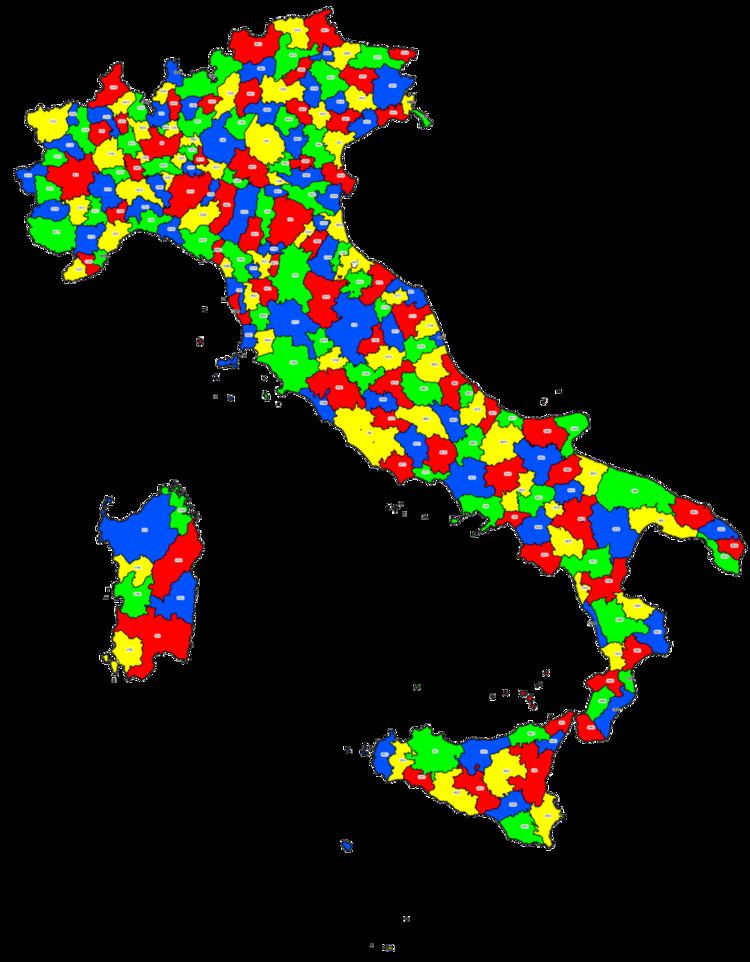Country Italy Type Open International call prefix 00 | Continent Europe Country calling code +39 | |
 | ||
Regulator Autorità per le Garanzie nelle Comunicazioni | ||
Telephone numbers in Italy are defined by a telephone numbering plan that is organized by types of services. Landline numbers and mobile phone numbers are easily recognizable: the former start with 0 and the latter start with 3. Other initial digits denote other services, such as emergency and toll-free numbers.
Contents
- Number formats
- Landline numbers
- Mobile phone numbers
- Emergency and service numbers
- Special rate numbers
- Other numbers
- Unassigned numbers
- Trunk code removal
- Mobile numbers prefix shortening
- Other changes
- Campione dItalia
- San Marino
- Vatican City
- References
The country code for calling Italy from abroad is 39. The international prefix is 00, as is standard in most European countries. Four different emergency numbers exist, including 112.
Italy uses an open numbering plan in which the length of subscriber telephone numbers varies from six to eleven digits. The dialing procedures for callers mandate that the full telephone number is always dialed, including the area code, which is called prefix (prefisso in Italian).
When communicating phone numbers it is usual to group the digits, but there are no fixed rules for grouping. The same phone number is likely to be written or pronounced differently by different people. Several symbols can be used to group digits; spaces are common, but dots and hyphens are often seen as well.
Number formats
The minimum number length is 3 digits and the maximum is 12.
Landline numbers
Landline numbers start with the digit 0 and are 6 to 11 digits long, although they are rarely shorter than 9. They are composed of a variable length prefix followed by a variable length subscriber number.
Prefixes are assigned on a geographical basis, starting from the north of the country: for example Turin has prefix "011", Rome has "06" and Naples has "081".
Mobile phone numbers
Mobile phone numbers start with the digit 3 and are generally ten digits long. It is still possible, but rare, to find nine-digit numbers, which were the first to be assigned.
The first three digits of the mobile phone numbers (prefix) identify the mobile network operator that assigned the number, but since 2002 mobile number portability is possible and thus any number can end up being managed by any operator.
Some network operators allow the caller to insert additional digit in order to redirect phone calls to voice mail. For example dialing "36 339 7308986" will connect to the voice mail of the phone number "339 7308986". The extra digits required vary based on the network operator managing the number.
Emergency and service numbers
Emergency and service numbers start with the digit 1.
Four different emergency numbers are currently in use, but they are in the process of being replaced by 112, previously assigned to the gendarmerie, is already accepting any emergency calls in some areas. Calls to 112 are answered within seconds and in multiple languages.
The complete list of emergency numbers is:
Examples of service numbers are:
Special-rate numbers
Special-rate numbers start with 8 and include toll-free numbers (called green numbers, numeri verdi in Italian, starting with "80..."), shared-rate numbers ("84...") and premium-rate services ("89...").
Other numbers
Numbers starting with 4 are used for network-specific phone services like voice mailbox and various information services; they can be free, non-premium or premium.
Included in this category are, among others:
The digit 5 has been reserved for VoIP numbers.
Finally 7 is used for internet services such as virtual fax numbers and dial up internet access ("70...").
Unassigned numbers
Numbers starting with the digits 2, 6 and 9 are currently unassigned and reserved for future purposes.
Trunk code removal
In the past it was possible to omit the prefix when calling from a landline to another landline in the same area. The digit "0" was the trunk code and it had to be removed when calling from abroad.
This changed in 1998, with a transition period lasting from 19 June to 31 December. The new dial plan requires one to dial the full number for every call. The main advantage is the availability of millions of previously reserved phone numbers.
The change was widely advertised with a campaign named "Fissa il prefisso" ("Attach the prefix").
It was originally intended also to replace the leading "0" with "4" for landlines. This was scheduled to be implemented starting from 29 December 2000, but this never happened: "0" remained to identify landlines and "4" now identifies network services.
Example for calling the landline subscriber number "xxxxxxxx" in Rome:
Mobile numbers prefix shortening
Until 2001 a leading "0" was part of any mobile phone number, but it has been removed.
Example for calling the mobile phone number "3xx xxxxxxxx":
Other changes
Several other smaller changes occurred during the years: for example the prefix for toll free numbers changed from "167" to "800" in 1999.
Campione d'Italia
The Italian municipality Campione d'Italia, an exclave within the Swiss canton of Ticino, uses the Swiss telephone network and is part of the Swiss numbering plan.
San Marino
The Italian enclave San Marino has its own country code 378, but landline numbers can be reached using the Italian country code as well: the prefix "0549" is assigned to San Marino. Dialing either "+378 xxxxxx" or "+39 0549 xxxxxx" will reach the same number. Mobile phone customers are sometimes assigned Italian phone numbers.
Vatican City
The country code 379 is assigned to Vatican City, but it is not used: telephone numbers in Vatican City are integrated into the Italian numbering plan. Vatican landline telephone numbers are in the form "+39 06 698xxxxx", "+39" being the country code for Italy and "06" the prefix for Rome.
